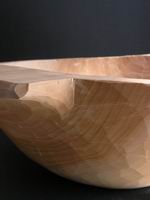Tibor Uhrín
The current understanding of a craft is often restricted to the ability to skilfully manipulate tools and material or to craft as a business. However, real craft means much more. Its fundamental characteristic is not only manual ability and skill but also something occurring in the craftsman’s subconscious mind. It is an intimate knowledge of the use and characteristics of tools, materials and craft procedures obtained by understanding traditions and gaining experience. Moreover, this is knowledge which allows the creator to overcome arising issues originating from the variety of tools, materials and work conditions. David Pye (1909 – 1993), English architect, craftsman and teacher of design, used the terms “creation with risk” and “creation with certainty” in order to describe two different principles of production differentiated according to whether the result of the work is given in advance and cannot be changed before the actual work starts, or whether it is uncertain with the possibility of change during the work. With his notions “creation with risk” and “creation with certainty”, he expressed two opposite sides of the problems. When the work functions “with certainty” the result cannot be incorrect because each operation is given based on the tools used and automated method of production. A craftsman who uses “creation with risk” works with his hands and without using machines or mechanisms, so the quality of work is not given in advance but depends on the estimation, skills, abilities and attention of the craftsman and his personal experience. The most important thing is that the quality of the work is threatened throughout the work process (and therefore “creation with risk”). Nowadays we hear much of the use of the notion “handmade”. However, many things that exist in our world are produced with an interchangeable proportion of use of both types of creations. Ever since the Middle Ages, a time when various tools and patterns started to be used and developed, the quality of tools has improved, new work methods developed, the craftsmen has reduced the “risk” and increased the “certainty”, so risk was slowly eliminated. A typical example of creation with risk is the work of a carver, for example, when creating a circular bowl entirely by using traditional tools. The carver’s craft requires extensive manual skill, practise and mastery. Any inexactness in the hand guiding the tool by slow and exact chips, can damage the whole job. A different technology – turning – is a model for creation on the border of “work with risk” and “work with certainty”. We can use various tools to fix the main tool or work with hand knives. There is neither full certainty nor full risk, only an inconstant balance between the two methods. A product a good craftsman makes by hand is usually valued higher precisely because of the presence of the risk while being made. The qualitative differences after the individual creation of each object are also visible, e.g. tool marks on the surface, small variances from the ideal geometrical shape. Without these signs of imperfectness, the art of craft and design becomes uninteresting. The objects therefore receive another level of value – unrepeatable craft quality. In some cases precision is required from the designer’s point of view, while in others it may not be necessary. A designer can design an artefact with leeway, and this allows the craftsman to implement the design using his own imagination. Some craftsmen let themselves be led by their skills, suppressing other connections or opinions. In contrast with such spiritless conformity, we sometimes prefer to value craft work for its rawness, spontaneity or originality. With regard to quality, creation with risk does not hold a specific position. What is interesting about it is great variability as well as the influence of art and design. Without this variability craft would be boring and poor. The craftsman’s hand is not always good, and industrial production is not always bad or secondary. Continual dependency on technology makes us resolve the task connected with the loss of continuity of craft skills. Craft based on the representation of the unity of the hands and spirit can even nowadays ease this distance and confirm a human element in everyday life. The craft experience can offer great opportunity for expressing individuality.
